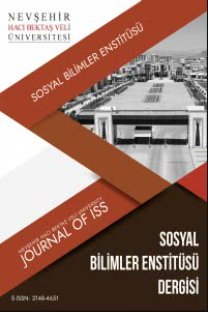DİJİTAL YAŞAM TEKNOLOJİLERİ BAĞLAMINDA AKILLI SAAT KULLANICILARININ DENEYİMLERİ ÜZERİNE NİTEL BİR ÇALIŞMA
Dijitalleşme, Akıllı Saat, Akademisyen
A QUALITATIVE STUDY ON THE EXPERIENCES OF SMART WATCH USERS IN THE CONTEXT OF DIGITAL LIFE TECHNOLOGIES
Digitalization, Smart Watch, Academician,
___
- Al-Fuqaha, A., Guizani, M., Mohammadi, M., Aledhari, M., & Ayyash, M. (2015). Internet of things: A survey on enabling technologies, protocols, and applications. IEEE Communications Surveys & Tutorials, 17(4), 2347-2376.
- Anggraini, N., Kaburuan, E. R., Wang, G., & Jayadi, R. (2019). Usability study and users’ perception of smartwatch: Study on Indonesian customer. Procedia Computer Science, 161, 1266-1274.
- Chopra, A., & Singhal, A. (2021). Understanding the Wearable Technology. Available at SSRN 3833316.
- Chuah, S. H. W., Rauschnabel, P. A., Krey, N., Nguyen, B., Ramayah, T., & Lade, S. (2016). Wearable technologies: The role of usefulness and visibility in smartwatch adoption. Computers in Human Behavior, 65, 276-284.
- Collier, R., Randolph, A. B., Collier, R., & Randolph, A. B. (2015). Wearable technologies for healthcare innovation. In Hilton Head Island: Proceedings of the Southern Association for Information Systems Conference.
- Creswell, J. W., (2017), Araştırma Deseni, Nitel, Nicel ve Karma Yöntem Yaklaşımları, (Çev. S. B. Demir), 3. Baskı, Ankara: Eğiten Kitap
- Çiçek, M. E. S. U. T. (2015). Wearable technologies and its future applications. International Journal of Electrical, Electronics and Data Communication, 3(4), 45-50.
- Hofmann, E., & Rüsch, M. (2017). Industry 4.0 and the current status as well as future prospects on logistics. Computers in industry, 89, 23-34.
- Jazdi, N. (2014, May). Cyber physical systems in the context of Industry 4.0. In 2014 IEEE international conference on automation, quality and testing, robotics (pp. 1-4). IEEE.
- Kaewkannate, K., & Kim, S. (2016). A comparison of wearable fitness devices. BMC public health, 16(1), 1-16.
- Kıral, B. (2021). Nitel araştırmada fenomenoloji deseni: türleri ve araştırma süreci. Eğitim ve Öğretim Araştırmaları Dergisi, 10(4), 92-103.
- Kumar, S. (2017). Technological and business perspective of wearable technology.
- Lundell, J., & Bates, C. (2016). Understanding user experience journeys for a smart watch device. In HCI in Business, Government, and Organizations: Information Systems: Third International Conference, HCIBGO 2016, Held as Part of HCI International 2016, Toronto, Canada, July 17-22, 2016, Proceedings, Part II 3 (pp. 424-433). Springer International Publishing.
- Majstorović, V. D., Velimirović, M., Glišić, M., Kostić, J., Đura, E., Rančić, M., & Mitrović, R. (2018). Cyber-physical manufacturing in context of industry 4.0 model. In International Conference on the Industry 4.0 model for Advanced Manufacturing (pp. 227–238). Springer
- Massoomi, M. R., & Handberg, E. M. (2019). Increasing and evolving role of smart devices in modern medicine. European Cardiology Review, 14(3), 181.
- Reeder, B., & David, A. (2016). Health at hand: A systematic review of smart watch uses for health and wellness. Journal of biomedical informatics, 63, 269-276.
- Silva, A., & Alturas, B. (2021, June). The benefits of the use of smartwatches in promoting regular physical activity. In 2021 16th Iberian Conference on Information Systems and Technologies (CISTI) (pp. 1-6). IEEE.
- Soylu, A. (2018). Endüstri 4.0 ve girişimcilikte yeni yaklaşımlar. Pamukkale Üniversitesi Sosyal Bilimler Enstitüsü Dergisi, (32), 43-57.
- Wang, I. (2017). Using Smartwatches to Improve Health and Wellness.
- Watier, K. (2003). Marketing Wearable Computers to Consumers: An Examination of Early Adopter Consumers’ Feelings and Attitudes toward Wearable Computers. Georgetown UniversityWilson, S., & Laing, R. (2018). Wearable technologies: Present and future. In Paper presented at the 91st world conference of the textile institute, leeds, UK.
- Yüksel, P. ve Yıldırım, S., (2015), “Theoretical frameworks, methods, and procedures for conducting phenomenological studies in educational settings”, Turkish Online Journal of Qualitative Inquiry, 6(1): 1-20.
- Zheng, Y. L., Ding, X. R., Poon, C. C. Y., Lo, B. P. L., Zhang, H., Zhou, X. L., Yang, G. Z., Zhao, N. & Zhang, Y. T. (2014). Unobtrusive sensing and wearable devices for health informatics. IEEE transactions on biomedical engineering, 61(5), pp 1538-1554 URL-1 https://builtin.com/wearables
- Yayın Aralığı: Yılda 4 Sayı
- Başlangıç: 2011
- Yayıncı: Nevşehir Hacı Bektaş Veli Üniversitesi
EVLİLİK DOYUMU ÖLÇEĞİ’NİN GELİŞTİRİLMESİ: GEÇERLİK VE GÜVENİRLİK ÇALIŞMASI
N. Büşra AKÇABOZAN KAYABOL, Pınar ÇAĞ, Ufuk AKBAŞ, Zeynep HATİPOĞLU SÜMER, Yaşar ÖZBAY, Gökçen AYDIN, Nurten KARACAN ÖZDEMİR, Cemre ERTEN TATLI, Esra EKER DURMUŞ
ENERJİ TÜKETİMİNİN İKTİSADİ BÜYÜME ÜZERİNDEKİ ETKİLERİNİN PANEL VERİ YÖNTEMİYLE İNCELENMESİ
Şeyma BOZKAYA, İbrahim AYTEKİN
GÜNCEL SOSYAL BİLGİLER DERS KİTAPLARINDA GİRİŞİMCİLİK
Murat Bayram YILAR, İrfan Davut ÇAM
ÇAĞATAY TÜRKÇESİ DÖNEMİ ESERLERİNDE PSİKOLOJİK BİR RAHATSIZLIK: DELİLİK OLGUSU
ULAŞTIRMA SEKTÖRÜNDEKİ ENERJİ TÜKETİMİ, EKONOMİK BÜYÜME VE ÇEVRESEL KALİTE İLİŞKİSİ
NÜFUS DEFTERLERİNE GÖRE ENEGİ (KAYMAKLI)
ANA DİLİ İNGİLİZCE OLMAYAN TÜRK YAZARLARIN İNGİLİZCE MAKALE ÖZETLERİNDEKİ HATALARIN ANALİZİ
